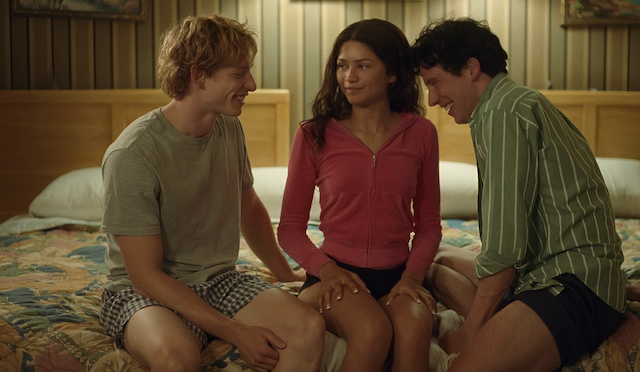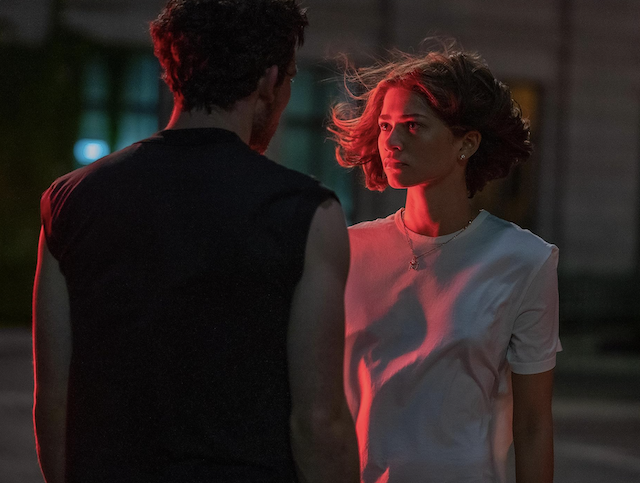
Photo by Metro Goldwyn Mayer Pictures – © 2023 Metro-Goldwyn-Mayer Pictures Inc. All Rights Reserved.
The complex, underlying emotions that drive interpersonal relationships are often brilliantly translated onto screen through visual means. That’s certainly the case for Academy Award-nominated Italian director Luca Guadagnino‘s latest movie, Challengers.
The filmmaker has long made a name for himself in Hollywood by exploring the complexities of young love and friendship in his features, notably Call Me by Your Name and Bones and All. Challengers is similar to his previous work, as it’s an emotional character study that explores how complications and happiness within close relationships impact all of those involved.
The romantic sports drama, which was written by Justin Kuritzkes, is told trough the lens of tennis in a nonlinear narrative. The sport serves as a mirror that reflects on the finesse and intensity that’s needed in personal relationships.
Challengers opens in 2019 during a match between Patrick Zweig (Josh O’Connor) and Art Donaldson (Mike Faist), who are watched intensely by Tashi Duncan (Zendaya) from the stands. The tension is palpable between the three adults, which hints that the trio has a shared history.

Photo by Niko Tavernise/Niko Tavernise – © 2024 Metro-Goldwyn-Mayer Pictures Inc. All Rights Reserved.
The story then travels back to when the boys first meet Tashi in 2006, after they win the boys’ junior doubles title at the US Open. Art and Patrick, who have been best friends since they were 12-years-old, find their bond is now being tested by not just their competitive natures, but also by their mutual affection for Tashi.
Patrick and Art both decide to pursue Tashi. She’s a highly lauded young tennis prospect in her own right, who decides to play college tennis at Stanford University instead of immediately going pro after she finishes high school.
The two friends are both inspired and intimidated by Tashi, who initially rebuffs their awkward advances. She lets them know that tennis is her only love, but Patrick and Art still compete for her attention.
Art ultimately becomes Tashi’s steadfast supporter while he also begins playing tennis at Stamford, while Patrick turns pro instead of going to college. Their interactions during those pivotal years forces them all to navigate the complications of love, loyalty and personal aspirations well into their adult lives.

Photo by Niko Tavernise / Metro Goldwyn M/Niko Tavernise / Metro Goldwyn – © 2023 Metro-Goldwyn-Mayer Pictures Inc. All Rights Reserved.
Kuritzkes’ script thrives in the development of its three truly unique, but equally complex, protagonists. The character development is amplified by the nonlinear approach he took in telling the story, which helped maintain the momentum of the tension and conflict between the main trio.
Captivatingly brought to the screen by O’Connor and Faist, Patrick and Art are realistic characters who have long accepted and embraced their flaws and desires, even if they infringe on the other’s happiness and success. The way the two actors deliver the writer’s dialogue embraces the parallels between how they play tennis and how they maneuver their unpredictable relationships off of the tennis court.
O’Connor and Faist also brought a palpable chemistry that transcends the initial simple rivalry their characters had in their tennis match esand for Tashi’s affections. Patrick and Art’s interactions empowers the movie’s idea that love and rivalry are not mutually exclusive.
Zendaya also shines on screen as she infused Tashi with an intimidating presence, both on and off the court. The Emmy-winning actress interwove strength and sophistication into her portrayal of her character, which instigated the growing personal and professional rivalry between Art and Patrick. While the character of Tashi isn’t as developed as her two male suitors, particularly in her own personal desires off the court, the actress thrived in stirring up desire in all three characters.
Tashi, Patrick and Art’s intense interactions on and off the tennis court is perfectly captured on screen by Challengers‘ cinematographer, Sayombhu Mukdeeprom. After garnering recognition for his collaboration with Guadagnino on Call Me By Your Name and the 2018 remake of Suspiria, the Director of Photography infused intriguing vantage points into his latest film. Whether framing the court from the umpire’s perspective when Patrick and Art are competing, or the characters hitting the tennis balls directly at the screen, Mukdeeprom immerses audiences in the drama’s most stellar frames.
Mukdeeprom’s cinematography is audibly driven by the hard-driving beats of Challengers‘ hypnotic techno score, which was composed by Oscar, Emmy and Grammy-winning musicians, Trent Reznor and Atticus Ross. Blending such diverse genres as disco and pulse-pounding EDM from the 21st century, the score is also essential in capturing Tashi, Patrick and Art’s intense personalities on and off the court.
Guadagnino further proves his appreciation for the aesthetics in his movies through the costumes he commissioned for the three protagonists in his latest feature by Jonathan Anderson. The latter, who serves as the creative director of luxury fashion house Loewe, crafted sportswear for Tashi, Patrick and Art that’s both practical and chic.
Tashi is dress immaculately both on and off the court, whether she’s in slouchy loungewear or a more professional collared shirtdress. Art, meanwhile, is donned in shorts and shirts adhered with brands that are endorsing him, while Patrick skips the pristine tennis outfits to reflect his more independent spirit.
Kuritzkes’ script for Challengers thrives in the development of its three truly unique, protagonists, which Guadagnino smoothly brings to the screen in the nonlinear narrative. Along with Zendaya, O’Connor and Faist’s stellar performances, the film shows the extent to which the fierce athleticism of tennis mirrors the high-stakes competition of shifting interpersonal dynamics. It’s a deeply human movie that showcases Guadagnino’s continuous determination to study the effects of emotional entanglements.
If you liked this article, please share your comment below.
Check out more of Karen Benardello’s articles.
Here’s the trailer of the film.

